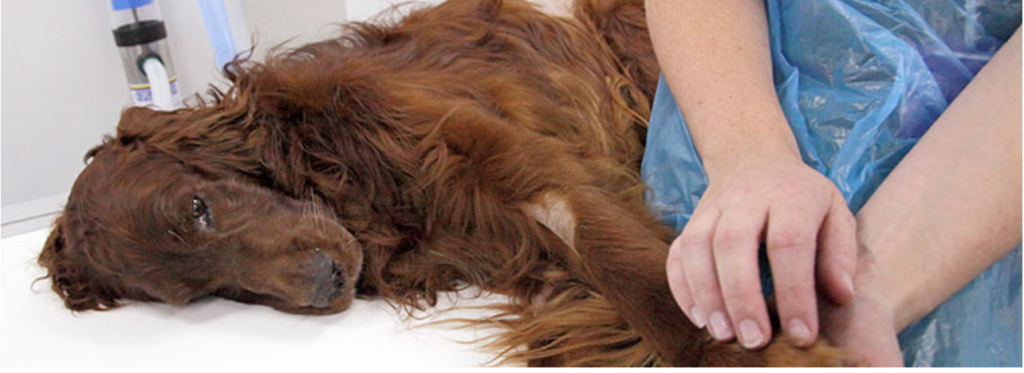
If you see these dog poisoning symptoms, you need to act fast. When it comes to life-threatening situations, every minute counts, and we all want the same thing, your dog, to live!
So read our dog poison symptoms carefully and be prepared in case your dog is suffering. It’s better to learn this now before you think your dog is poisoned.
Long-Term Dog Poisoning Symptoms
Beyond the more noticeable signals are some more serious, longer-term issues to keep an eye out for. Below are the different types of symptoms associated with dog poisoning.
Signs To Watch For Dog Poisoning
Many different types of dog poisoning have various symptoms. Overall, if you are afraid your dog has been poisoned, look out for these visible signs.
- Vomiting
- Diarrhea
- Seizures
- Blood in the stool
- Lethargy
- Loss of appetite
- Bruising
- Nosebleeds
- Irregular heartbeat
- Inability to urinate
If your dog is suffering from one of these things, you’ll want to get help immediately.
Symptoms Of Dog Poisoning
Beyond the more noticeable signals are some more serious, longer-term issues to keep an eye out for. Below are the different types of symptoms associated with dog poisoning.
Irregular Heart Beats
Dogs with irregular heart rhythms and cardiac symptoms have most likely gotten into a medication or plant. This includes jimson weed, kalanchoe, milkweed, mountain laurel, and oleander.
Kidney Failure
Antifreeze poisoning can cause your dog kidney failure and the inability to produce urine. Plants can also cause kidney damage. These types of plants include dieffenbachia, Easter lily, caladium, pigweed, and philodendron. Learn more in our guide to poisonous plants.
Plants & Flowers Poisonous To Dogs
The following plants and flowers shouldn’t be around dogs because of the side effects they cause. Some can be lethal, so be cautious and remove these plants from your home and keep them out of your flower beds and garden to keep your dog safe. The level of toxicity depends on the amount ingested and your pet’s size.
- Angel’s Trumpet
- Aloe Vera (Succulent)
- Autumn Crocus*
- Avocados
- Azalea*
- Baby’s Breath
- Begonia
- Calla Lily
- Chrysanthemum
- Citronella
- Daffodil
- Day Lily
- Easter Lily
- Elephant’s Ear
- Euphorbias (Succulent)
- Foxglove*
- Garlic
- Geranium
- Hyacinth*
- Grapes
- Hydrangea*
- Indian Rubber Tree (aka Weeping Fig Tree)
- Jade (Succulent)
- Japanese Pieris*
- Japanese Rubber Plant (aka Jade Plant)
- Kalanchoes (Succulent)
- Larkspur
- Lily of the Valley*
- Lupine
- Monkshood*
- Morning Glory
- Mums
- Oleander*
- Onions
- Peonie
- Rhododendron*
- Rhubarb (leaves)
- Sago Palm
- Shamrock Plants
- Silver Dollar (Succulent)
- Snake Plants
- Tiger Lily
- Tomato Plants (leaves and green tomatoes)
- Tulip
- Yesterday, Today & Tomorrow
- Yew*
- Yucca Plants
*Cardiotoxic plants pose the highest risk to your pet because they cause the heart to weaken.
NOTE: This list is not fully comprehensive but includes some of the most common garden plants.
Liver Damage
Medications like acetaminophen and plants such as tansy ragwort or rattlebox can cause liver damage.
Loss Of Blood
If your dog has bruising, blood in their stool, nosebleeds, or anemia, they have most likely gotten into rat or mouse poison. However, if they’ve brought into your garden or kitchen and overeaten onion, garlic, sweet clover, or bracken fern, they could also suffer from anemia and could even die.
Neurological Symptoms

Dogs suffering from seizures and other neurological symptoms have possibly ingested one of many things. This list is long and includes the following:
- antidepressants
- alcohol
- aspirin
- drain cleaners
- dishwasher soap
- gasoline
- marijuana (learn more about dogs and marijuana)
- flea repellents
- tobacco
- furniture polish
- strychnine.
Exposure to, or bites from, poisonous animals can cause dogs to seize as well. These animals include certain breeds of snakes, spiders, toads, and frogs. Specifically, you’ll want to look out for Florida marine toads, Coral snakes, Colorado River toads, and brown recluse spiders. Read about how a venomous snake bite nearly killed my dog.
Plants can cause neurological symptoms as well; this includes buckeyes and horse chestnuts.
Stomach Concerns
Garbage, lead paint, English ivy, English holly, snake bites, chocolate, medications, poinsettia, iris, Chinaberry, daphne, and pokeweed are dangerous dogs. Digesting these substances can result in gastrointestinal symptoms such as diarrhea, loss of appetite, and vomiting.
What Foods Are Dangerous To Dogs?
In 2011, dogs eating toxic foods was the #1 cause of dog poisoning. It’s impossible to watch your dog 24/7, but if you know there’s something your dog shouldn’t get into, you should put it up high in a cupboard, or somewhere else you know they can’t reach. Dogs eating chocolate or grapes is preventable. Be cautious of where you place your food, and check out our extensive list of foods dogs should not eat.
To learn more about the dangers of dogs eating chocolate, watch this video below.
Our First-Hand Experience
We all know our dogs get into things they aren’t supposed to. So, it’s our job to keep hazards away from them. But sometimes accidents happen to even the best dog parents. One of our team members shares her brush with a scary situation and how it panned out.
Tips To Keep In Mind
Program your vet’s phone number into your phone as well as the emergency vet. You should also have it written down in a place you can find easily at home.
If you think your dog has poison symptoms, don’t hesitate to call the vet or poison control hotline. Explain your situation. Ask them for advice on what steps to take next.
Remember, you must learn these things now before your dog is in distress so that you can act quickly and efficiently if trouble arises.
